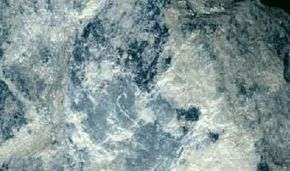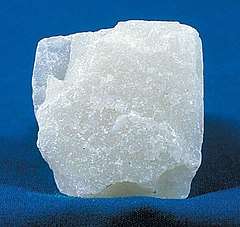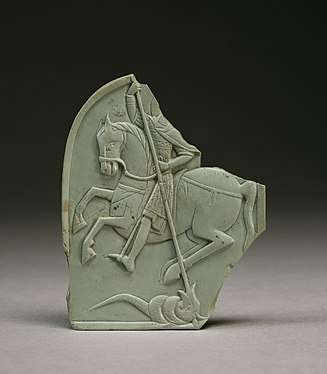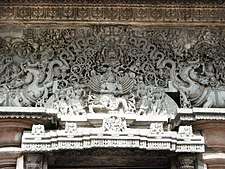Soapstone
Soapstone (also known as steatite or soaprock) is a talc-schist, which is a type of metamorphic rock. It is composed largely of the magnesium rich mineral talc. It is produced by dynamothermal metamorphism and metasomatism, which occur in the zones where tectonic plates are subducted, changing rocks by heat and pressure, with influx of fluids, but without melting. It has been a medium for carving for thousands of years.

Petrology

Petrologically, soapstone is composed dominantly of talc, with varying amounts of chlorite and amphiboles (typically tremolite, anthophyllite, and cummingtonite, hence its obsolete name, magnesiocummingtonite), and trace to minor iron-chromium oxides. It may be schistose or massive. Soapstone is formed by the metamorphism of ultramafic protoliths (e.g. dunite or serpentinite) and the metasomatism of siliceous dolomites.
By mass, "pure" steatite is roughly 63.37% silica, 31.88% magnesia, and 4.74% water.[1] It commonly contains minor quantities of other oxides such as CaO or Al2O3.
Pyrophyllite, a mineral very similar to talc, is sometimes called soapstone in the generic sense, since its physical characteristics and industrial uses are similar,[2] and because it is also commonly used as a carving material. However, this mineral typically does not have such a soapy feel as soapstone.
Physical characteristics
Soapstone is relatively soft because of its high talc content, talc having a definitional value of 1 on the Mohs hardness scale. Softer grades may feel similar to soap when touched, hence the name. No fixed hardness is given for soapstone because the amount of talc it contains varies widely, from as little as 30% for architectural grades such as those used on countertops, to as much as 80% for carving grades.
Soapstone is easy to carve, it is also durable, heat-resistant and has a high heat storage capacity. It has therefore been used for cooking and heating equipment for thousands of years.[3]
Soapstone is often used as an insulator for housing and electrical components, due to its durability and electrical characteristics and because it can be pressed into complex shapes before firing. Soapstone undergoes transformations when heated to temperatures of 1,000–1,200 °C (1,830–2,190 °F) into enstatite and cristobalite; on the Mohs scale, this corresponds to an increase in hardness to 5.5–6.5.[4]
Uses
Historical uses

The Qulliq, a type of oil lamp made by the arctic peoples, are also known as soapstone lamps. This kind of lamp was the single most important article of furniture for the Inuit peoples in their dwellings.
Ancient Egyptian Scarab signet/amulets were most commonly made from glazed steatite.[5]
Soapstone is used for inlaid designs, sculpture, coasters, and kitchen countertops and sinks. The Inuit often used soapstone for traditional carvings. Some Native American tribes and bands make bowls, cooking slabs, and other objects from soapstone; historically, this was particularly common during the Late Archaic archaeological period.[6]
Locally quarried soapstone was used for gravemarkers in 19th century northeast Georgia, US, around Dahlonega, and Cleveland, as simple field stone and "slot and tab" tombs.
Small blocks of soapstone (8" x 10" x 1") were heated on the cookstove or near the fire and used to warm cold bedclothes or to keep hands and feet cozy while sleighing.
Soapstone is relatively abundant in northern Europe. Vikings hewed soapstone directly from the stone face, shaped it into cooking pots, and sold these at home and abroad.[7] In Shetland, there is evidence these vessels were used for processing marine and dairy fats.[8] Several medieval buildings have survived here which are constructed with soapstone, amongst them Nidaros Cathedral.[3]
Soapstone is sometimes used for construction of fireplace surrounds, cladding on wood-burning stoves,[9][10] and as the preferred material for woodburning masonry heaters because it can absorb, store, and evenly radiate heat due to its high density and magnesite (MgCO3) content. It is also used for countertops and bathroom tiling because of the ease of working the material and its property as the "quiet stone". A weathered or aged appearance occurs naturally over time as the patina is enhanced.
The ancient trading city of Tepe Yahya in southeastern Iran was a center for the production and distribution of soapstone in the fifth to third millennia BC.[11] It was also used in Minoan Crete. At the Palace of Knossos, archaeological recovery has included a magnificent libation table made of steatite.[12] The Yoruba people of West Nigeria used soapstone for several statues, most notably at Esie, where archaeologists have uncovered hundreds of male and female statues about half of life size. The Yoruba of Ife also produced a miniature soapstone obelisk with metal studs called superstitiously "the staff of Oranmiyan".

Modern uses
Soapstone has been used in India for centuries as a medium for carving. Mining to meet worldwide demand for soapstone is threatening the habitat of India's tigers.[13]
In Brazil, especially in Minas Gerais, due to the abundance of soapstone mines in that Brazilian state, local artisans still craft objects from that material, including pots and pans, wine glasses, statues, jewel boxes, coasters, and vases. These handicrafts are commonly sold in street markets found in cities across the state. Some of the oldest towns, notably Congonhas, Tiradentes, and Ouro Preto, still have some of their streets paved with soapstone from colonial times.
Some Native Americans use soapstone for smoking pipes; numerous examples have been found among artifacts of different cultures and are still in use today. Its low heat conduction allows for prolonged smoking without the pipe heating up uncomfortably.[14]
Pipes and decorative carvings of local animals were made out of soapstone by Australian Aboriginal artist Erlikilyika (c.1865–c.1930) in Central Australia.[15]
Some wood-burning stoves make use of soapstone to take advantage of its useful thermal and fire-resistant properties.[9][10]
Soapstone is also used to carve Chinese seals.
Currently, soapstone is most commonly used for architectural applications, such as counter tops, floor tiles, showerbases, and interior surfacing.
The active North American soapstone mines include one south of Quebec City with products marketed by Canadian Soapstone, the Treasure and Regal mines in Beaverhead County, Montana mined by the Barretts Minerals Company, and another in Central Virginia operated by the Alberene Soapstone Company. Architectural soapstone is mined in Canada, Brazil, India, and Finland and imported into the United States.[16]
Welders and fabricators use soapstone as a marker due to its resistance to heat; it remains visible when heat is applied. It has also been used for many years by seamstresses, carpenters, and other craftsmen as a marking tool because its marks are visible and not permanent.
Soapstone can be used to create molds for casting objects from soft metals, such as pewter or silver. The soft stone is easily carved and is not degraded by heating. The slick surface of soapstone allows the finished object to be easily removed.
Soapstones can be put in a freezer and later used in place of ice cubes to chill alcoholic beverages without diluting. Sometimes called whiskey stones, these were first introduced around 2007. Most whiskey stones feature a semipolished finish, retaining the soft look of natural soapstone, while others are highly polished.
Steatite ceramics are low-cost biaxial porcelains of nominal composition (MgO)3(SiO2)4.[17] Steatite is used primarily for its dielectric and thermal insulating properties in applications such as tile, substrates, washers, bushings, beads, and pigments.[18] It is also used for high-voltage insulators, which have to stand large mechanical loads, e.g. insulators of mast radiators.
Safety
People can be exposed to soapstone in the workplace by breathing it in, skin contact, or eye contact.
United States
The Occupational Safety and Health Administration has set the legal limit (permissible exposure limit) for soapstone exposure in the workplace as 20 million particles per cubic foot over an 8-hour workday. The National Institute for Occupational Safety and Health has set a recommended exposure limit of 6 mg/m3 total exposure and 3 mg/m3 respiratory exposure over an 8-hour workday. At levels of 3000 mg/m3, soapstone is immediately dangerous to life and health.[19]
Other names
- Combarbalite stone, exclusively mined in Combarbalá, Chile, is known for its many colors. While they are not visible during mining, they appear after refining.
- Palewa and gorara stones are types of Indian soapstone.
- A variety of other regional and marketing names for soapstone are used.[20]
Gallery
 A 12th-century Byzantine relief of Saint George and the Dragon
A 12th-century Byzantine relief of Saint George and the Dragon
 Soapstone slot-and-tab tomb in Dahlonega, Georgia
Soapstone slot-and-tab tomb in Dahlonega, Georgia
 An Egyptian carved and glazed steatite scarab amulet
An Egyptian carved and glazed steatite scarab amulet Steatite scarab at the Walters Art Museum
Steatite scarab at the Walters Art Museum Nidaros Cathedral in Trondheim, Norway, constructed mainly of soapstone
Nidaros Cathedral in Trondheim, Norway, constructed mainly of soapstone
See also
References
- Anthony, John W.; Bideaux, Richard A.; Bladh, Kenneth W.; Nichols, Monte C., eds. (1995). "Talc" (PDF). Handbook of Mineralogy. II (Silica, Silicates). Chantilly, VA: Mineralogical Society of America. ISBN 0962209716.
- Virta, Robert L. Minerals Yearbook Metals and Minerals 2010. Government Printing Office. p. 75.1. ISBN 9788290273908. Retrieved 26 November 2018.
- Hansen, Gitte; Storemyr, Per (2017). A Versatile Resource – The Procurement and Use of Soapstone in Norway and The North Atlantic Region. In: Soapstone in the North Quarries, Products and People 7000 BC – AD 1700. UBAS – University of Bergen Archaeological Series 9. Bergen, Norway. ISBN 978-82-90273-90-8.
- "Some Important Aspects of the Harappan Technological Tradition," Bhan KK, Vidale M and Kenoyer JM, in Indian Archaeology in Retrospect/edited by S. Settar and Ravi Korisettar, Manohar Press, New Delhi, 2002.
- Aldred, Cyril (1971). Jewels of the Pharaohs Egyptian Jewellery of the Dynastic Period. Thames and Hudson. pp. 160–161. ISBN 0500231389.
- Kenneth E. Sassaman (1993-03-30). Early Pottery in the Southeast: Tradition and Innovation in Cooking Technology. University Alabama Press. ISBN 978-0-8173-0670-0.
- Else Rosendahl, The Vikings, The Penguin Press, 1987, page 105
- Steele, Val. "Report on the analysis of residues from steatite and ceramic vessels from the site of Belmont, Shetland" (PDF). Shetland Amenity.
- Weideman, Paul (2017-11-05). "There's a stove for every taste". The Santa Fe New Mexican. Retrieved 2017-12-14.
- Damrosch, Barbara (2017-01-19). "The enduring appeal of wood stoves". The Washington Post. Retrieved 2017-12-14.
- "Tepe Yahya," Encyclopædia Britannica, 2004. Britannica Concise Encyclopedia. 3 January 2004, Britannica.com
- C.Michael Hogan (2007) "Knossos Fieldnotes", The Modern Antiquarian
- Barnett, Antony (2003-06-22). "West's love of talc threatens India's tigers". The Guardian. London. Retrieved 2007-01-09.
- Witthoft, J.G., 1949, "Stone Pipes of the Historic Cherokees", Southern Indian Studies 1(2):43–62.
- Kelham, Megg (November 2010). "A Museum in Finke: An Aputula Heritage Project" (PDF). See Territory Stories for details of document: 1–97. Retrieved 11 May 2019. Cite journal requires
|journal=(help) - "Soapstone gives countertops, tiles a look that's both new and old". The Washington Post. Retrieved 2014-01-11.
- "Royalty Minerals". royaltyminerals.in. Retrieved 26 November 2018.
- "Superior Technical Ceramics". Retrieved 26 November 2018.
- "CDC - NIOSH Pocket Guide to Chemical Hazards - Soapstone (containing less than 1% quartz)". www.cdc.gov. Retrieved 2015-11-21.
- "CST Personal Home Pages". cst.cmich.edu. Retrieved 26 November 2018.
- "Soapstone sculptures". hoysala.in. 2008. Archived from the original on 15 February 2009. Retrieved 26 November 2018.
Further reading
- Felce, Robert (2011) Soaprock Coast... The origins of English porcelain ISBN 978-0-956-9895-0-5
External links
| Wikimedia Commons has media related to Soapstone. |
- Soapstone Calculated Refractory Data w/ Technical Properties Converter (Incl. Soapstone Volume vs. Weight measuring units)
- Ancient soapstone bowl (The Central States Archaeological Journal)
- Soapstone Native American quarries, Maryland (Geological Society of America)
- Prehistoric soapstone use in northeastern Maryland (Antiquity Journal)
- The Blue Rock Soapstone Quarry, Yancey County, NC (North Carolina Office of State Archaeology)
- CDC - NIOSH Pocket Guide to Chemical Hazards
- Steatite historical marker in Decatur, Georgia